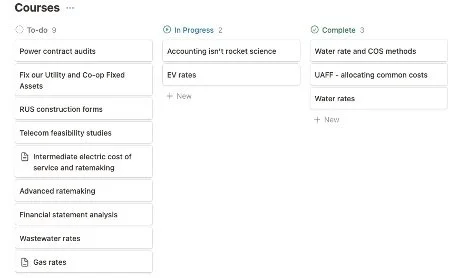Managing projects with Kanban
Kanban will help you rethink project management
Kanban is a project management framework that visualizes work and helps teams manage their workflow efficiently. Many individuals are more visually driven vs. word and list driven. Kanban shows at a glance the status of specific tasks within a project, identifies bottlenecks, and can help show individuals who have been assigned more tasks than they can deliver.
Kanban is a tool that is a staple of many productivity apps, such as Evernote, Asana, ToDoIst, Notion, and similar apps. It sounds exotic, but it is an adaptation of a “to-do list” and intuitively easy to implement. A basic Kanban board is shown in Illustration 1:
You can definitely break this down into smaller tasks, assigning steps to team members, and tracking progress on a more detailed scale.
Keys to managing projects with Kanban
1. Define the workflow: Start by identifying and customizing the stages or steps to complete the project. These could be tasks like “To Do,” “In Progress,” and “Done.”
2. Create a Kanban board: Set up a physical or digital Kanban board to visualize the workflow. Divide the Board into columns representing each stage of the process. Use sticky notes or cards to represent individual tasks on physical boards. The digital Board shown in Illustration 1 will have movable boxes for each task.
3. Populate the Board: Write down each task or deliverable on a sticky note or card and place it in the far left “To Do” column. Add details such as task descriptions, deadlines, and assignees.
4. Track progress: As work progresses, move the cards/tasks across the Board to reflect their current status. Each task should flow through the columns from left to right, indicating progress.
5. Limit work in progress (WIP): To avoid bottlenecks and maximize efficiency, set WIP limits for each column. This restricts the number of tasks that can be in progress simultaneously, encouraging focus and smoother flow.
6. Prioritize and reprioritize: The Project Manager should continuously assess the priority of tasks and adjust their positions on the Board accordingly. This allows the team to focus on more critical tasks and adapt to changing project needs.
7. Hold regular stand-up meetings: Conduct short, daily meetings to discuss progress, address any issues or obstacles, and ensure everyone is aligned. These meetings help teams stay informed and make necessary adjustments.
8. Continuous improvement: Regularly review the Kanban process to identify areas for improvement. Encourage team members to suggest changes and experiment with new techniques to enhance productivity.
Kanban, effective or a gimmick?
Is Kanban a takeoff on other project management tools? I’d say that Kanban is an improvement on the whiteboard project management technique, and there are also digital options for sharing and updating a Kanban project board among far-flung remote team members. Kanban is flexible and can be adapted to suit the project’s unique requirements. Kanban promotes transparency, collaboration, and efficient task management, enabling teams to deliver projects effectively.
If your team struggles with project management, this visual approach might be a viable option.
About Russ Hissom - Article Author
Russ Hissom, CPA is a principal of Utility Accounting & Rates Specialists a firm that provides power and utilities rate, expert witness, and consulting services, and online/on-demand courses on accounting, rates, FERC/RUS construction accounting, financial analysis, and business process improvement services. Russ was a partner in a national accounting and consulting firm for 20 years. He works with electric investor-owned and public power utilities, electric cooperatives, broadband providers, and gas, water, and wastewater utilities. His goal is to share industry best practices to help your business perform effectively and efficiently and meet the challenges of the changing power and utilities industry.
Find out more about Utility Accounting & Rates Specialists here, or you can reach Russ at russ.hissom@utilityeducation.com.
The material in this article is for informational purposes only and should not be taken as legal or accounting advice provided by Utility Accounting & Rates Specialists. You should seek formal advice on this topic from your accounting or legal advisor.

